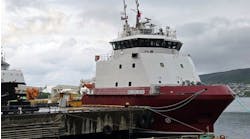Callovian salt mass gets new appraisal
Jack M. Reed
Consultant
There is evidence, in the form of deepwater seismic and recorded gravity data, that the Jurassic (Callovian) salt layer extends under the deepwater portion of the Gulf of Mexico basin between the Sigsbee Knoll salt mass and the Exterior Basin salt mass located north of the Sigsbee Escarpment (Fig. 1).
The reclassification of the current basement complex, found in this area of the deepwater Gulf, from igneous to salt, greatly enhances the exploration potential of over 32,000 sq mi of Amery Terrace, Walker Ridge, Lund, Lund South, Atwater Valley, Henderson, and LLoyd Ridge leasing areas. This is an area approximately the size of the state of Maine.
It is recognized that drilling for hydrocarbons in this area is technically and financially prohibitive at this time. However, with the rate of current advancements in deepwater drilling and world depletion of petroleum reserves, this area will soon be a major player in petroleum activity.
Tectonics has played an active part in molding nearly every part of this planet we live on. A postulated long-term passive situation (no tectonic activity) existing in the large Gulf basin since mid-Jurassic would be very unusual. During this same period of time the adjoining areas around the Gulf experienced major orogenic disturbances (Wilson, 1993). There should be tectonic activity in this basin with accompanying plate movement, and, if so, would categorize it as a tectonically “active” basin (Reed, 1994, 1995, 2001 and Shirley and Reed 2002). This active basin building theory for the GoM reveals several new exploration trends across this basin. This paper will discuss one of these trends.
Sigsbee Deep salt mass
A passive Gulf theory implies that there is no Jurassic (Callovian) salt layer extending under the deepwater portion of theGoMbasin between the salt mass of the Sigsbee Knoll complex and the Exterior Basin salt mass located north of the Sigsbee Escarpment (Fig. 1), (Salvador, 1987; Sawyer, 1991; Marton, 1993; and Bird, 2205). An active Gulf theory states that there is salt extending between these two complexes. If the active Gulf basin theory is correct then there should be some form of geophysical evidence in the deepwater Gulf that would indicate the presence of a continuous salt layer.
Gravity maps of the basin along with seismic data from deeper parts of the basin were procured. Gravity data were furnished by the petroleum industry (Fig. 1). The Institute for Geophysics at The University of Texas provided 2-D deepwater seismic line 16-2 that was recorded in the late 1970s (Fig. 2). Shown in Figures 3 and 4 are deepwater seismic reflection lines obtained from TGS-NOPEC Geophysical Company’s deepwater seismic projects Phase 45 (1997-98) and Phase 47 (1999).
The older deepwater U.T. data is the only usable data found in the deepwater GoM. Line 16-2 of this data bank has good seismic penetration to 8+ seconds where it records a well-defined top-of-salt (Jurassic) event. Therefore, this line was used for this study.
Line (16-2) extends northeast from the Sigsbee Knoll complex, across the deepwater plain of the eastern Gulf basin, and intersects the northern end of the Florida Escarpment. A portion of this line is displayed in Figure 2 with its location shown in Fig. 1. Two TGS-NOPEC lines (Fig. 3 & 4) intersect the U.T. line, as shown in Fig. 1, and trend northwest where they extend over the Sigsbee Escarpment into the Exterior Salt Basin.
Fig. 2 was then joined with Fig. 3 & 4 at their respective intersection points to form composite seismic lines extending across the deep Sigsbee basin. These very long lines should demonstrate the continuity of a Louann salt layer across the deepwater portion of the GoM, if it exists. The results are the composite lines Fig. 2-Fig. 3 (length = 580 mi) and Fig. 2-Fig. 4 (length = 520 mi) used for this research.
An examination of the Fig. 2-Fig. 3 composite demonstrates the top-of-salt event can very easily be followed along Fig. 2 from the Sigsbee Knoll salt mass to the large structural anomaly B. Fig. 3 intersects Fig. 2 near the crest of anomaly B and displays a well-defined and more developed portion of the structure which extends 30 to 35 mi in a northwest direction.
When the location of this large anomaly B is transposed onto the residual gravity map (Fig. 1) its location is found to be under a well-defined gravity minimum closure. Therefore, both seismic and gravity data strongly suggest that this anomaly is a salt structure. From structure B the salt outline can then be followed northwest, along the TGS-NOPEC line (Fig. 3), to the Sigsbee Escarpment where the salt layer is recorded joining up with the salt of the Exterior Basin.
Composite Fig. 2-Fig. 4 displays a well-defined, large, deep structural anomaly A. The top-of- salt event that outlines this structure can be followed southeast along the TGS-NOPEC line to the tie point of Fig 2. Here the event is seen combining with the salt event of Fig. 2.
The gravity map of Fig. 1 records an equally sizable gravity minimum response for this structure. Again, seismic and gravity data strongly suggest that this anomaly is a salt structure. From structure A this well-defined top-of-salt event extends NW along the TGS line to a location below and slightly SE of the Sigsbee Escarpment. Here the salt layer can again be seen coalescing with the Exterior Basin salt mass.
The salt layer, found between the exterior basin salt mass and the Sigsbee Knoll salt mass, supports an active Gulf building model. The model states that there is a salt connection between the Sigsbee Knoll salt mass and the Exterior Basin salt mass.
Plate separation and lithospheric doming began over the length the Cretaceous Shelf Edge (CSE) near the end of Early Cretaceous.
Doming of the asthenosphere along this structure, accompanied with the overburden pressure of the post-salt sediments, flushed the salt from the axis of this long feature. With the completion of this lengthy salt weld the original, large Callovian salt basin was divided into the two parts that we now call the Interior Salt Basin and Exterior Salt Basin. Doming of the asthenosphere brought igneous material near the surface and provided volcanic activity over the length of the structure. This doming also furnished a strong linear magnetic signature that currently outlines the CSE.
Separation of the plate began slightly south of, and parallel to, the CSE. As the “GoM plate” separated and began to move south, overburden pressure from Late Jurassic and Early Cretaceous sedimentary units forced the thick, underlying autochthonous salt northward into the ever-widening gap between the two separating plates.
This, now allochthonous, salt mass filled the expanding space between the separating plates and immediately covered the resulting igneous basement complex being exposed (Fig. 5, from Sawyer, 1991). During this process the enlarging exterior basin salt mass was covered by sediments of each following contemporaneous period (Reed, 1994). Transform movements for this separation was along the east coast of Mexico (right-lateral) and the Florida Escarpment (left-lateral). This process gradually formed the Exterior Basin as we see it today. The northern edge of this south moving plate is recorded on Fig. 4 & 5 where its location is below and slightly in front of the Sigsbee Escarpment.
Depositional sequences recorded on Fig. 4 & 5 also support plate separation and salt movement. Early doming along the CSE resulted in Paleocene through Eocene thinning to the north onto this structure. However, the gradual removal of salt from beneath the northern portion of this plate caused the plate to gradually tilt in a northern direction. With this action the following subsequent post Eocene sequence thickened northward.•
The author would like to thank Patricia Ganey-Curry at the Institute for Geophysics, U.T. and Christopher Corona at TGS-NOPEC Geophysical Co. Their help made this paper possible.
References
Bird, D. E., Burke, K., Hall, S. A., Casey, J. F., 2005, Gulf of Mexico tectonic history: Hotspot tracks, crustal boundaries, and early salt distribution: AAPG Bulletin, v. 89, (3), p. 311-328.
Marton, G., Buffler, R. T., 1993, The southeastern Gulf of Mexico in the framework of the opening of the Gulf of Mexico Basin: GCSSEPM Foundation 13th Annual Research Conference, p. 51-67.
Reed, J. M., 1994, Probable Cretaceous to Recent rifting in the Gulf of Mexico Basin, Part 1: Journal of Petroleum Geology, v. 17, (4), p. 429-444.
Reed, J. M., 1995, Probable Cretaceous to Recent rifting in the Gulf of Mexico Basin, Part 2: Journal of Petroleum Geology, v. 18, (1), 49-74.
Reed, J. M., 2001, Cretaceous to Recent Rifting in the Gulf of Mexico Basin: Gulf Coast Association of Geological Societies Transactions, v. LI, p. 273-284.
Salvador, A., 1987, Late Triassic-Jurassic paleogeography and origin of Gulf of Mexico basin: AAPG Bull., v. 71, (4), p. 419-451.
Sawyer, D. S., Buffler, R. T., Pilger, R. H., Jr., 1991, The crust under the Gulf of Mexico basin, In A. Salvador, ed., The Gulf of Mexico Basin, Boulder, CO, Geological Society of America, The Geology of North America, v. J, p. 53-72.
Shirley, K., Reed, J. M., 2002, Gulf’s evolution makes the shakes: AAPG Explorer, v. 23 (11), p. 20 & 35.
Wilson, H. H., 1993, The age of salt in the Gulf of Mexico Basin: Journal of Petroleum Geology, v. 16, (2), p. 125-152.







